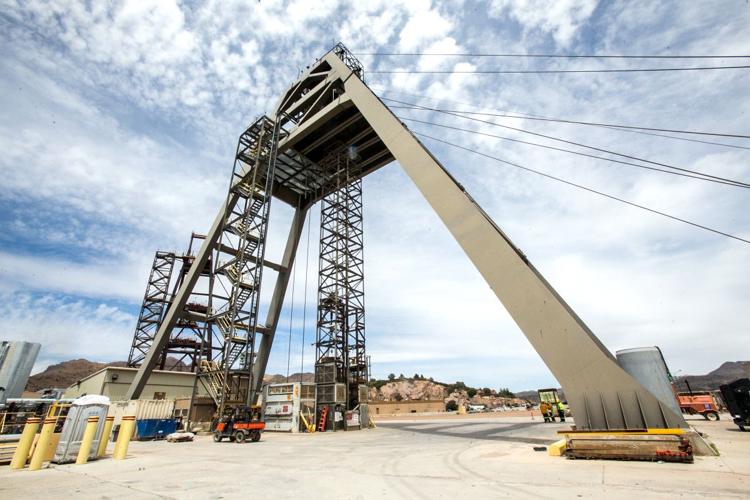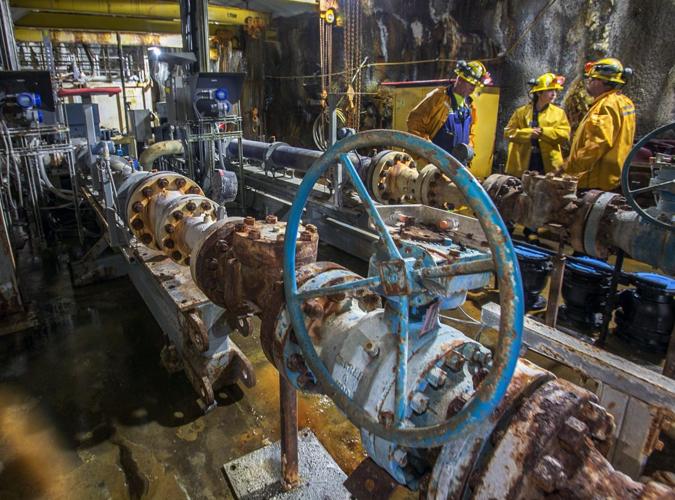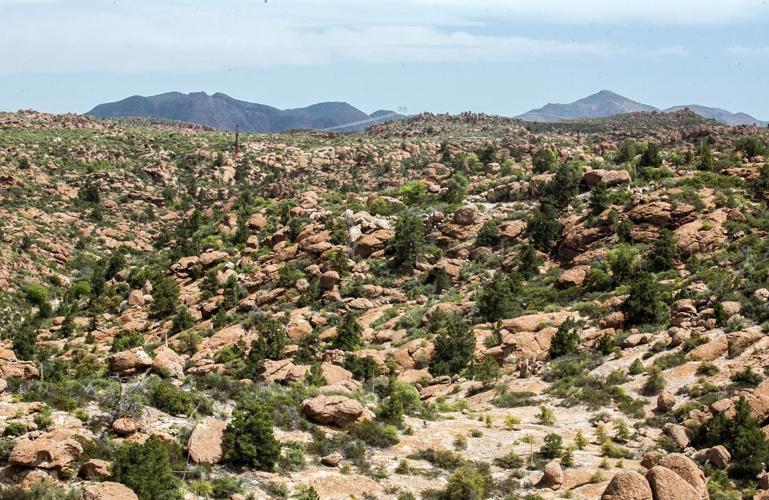The gaping mouth of Resolution Copper Mining’s No. 10 shaft is 28 feet across and opens into a sheer drop of nearly 7,000 feet, making it the deepest continuous mine shaft in the United States.
It’s also probably the deepest location where Arizona news reporters have roamed.
In recent months, Resolution Copper Mining — a subsidiary of mining giants London-based Rio Tinto Group and Australia-based BHP Billiton Ltd. — has brought journalists, decked out in helmets, boots and safety harnesses, on tours down the dark shaft. Bloomberg News took a tour last December. Reporters from Arizona Public Media and Phoenix’s Fox 10 ventured down earlier this year. The Star took a turn in April.
“We’ve got a great story,” Resolution project director Andrew Taplin said. “We’re going to generate a lot of economic benefits and we want to tell our story.”
Once the mine is operational — likely not for another 10 years — it’s expected to produce 25 percent of the U.S. copper supply, or about 1 billion tons annually. Supporters say it will help revive the flagging economy of Superior, which has weathered the boom-and-bust cycle of mining for generations.
But opponents say the media tours are an effort to distract from controversy over the mine’s expected environmental impacts and the damage it will do to the Oak Flat recreation area, considered sacred to Native Americans and recently added to the National Register of Historic Places.
“They have to keep the public interest up, especially when the opposition is growing so dramatically,” said Roy Chavez, a former miner and director of the Concerned Citizens and Retired Miners Coalition, which opposes the mine. He is also a former mayor of Superior.
Resolution, which in 2004 acquired the shuttered Magma Mine operation, has so far spent more than $1 billion expanding the mine, including build-out of two mine shafts. Before it even begins extracting copper, Resolution will have spent about $8 billion on mine construction, including finishing an existing shaft and adding four more.
Opponents still hope for a repeal of the controversial land-swap deal that gave 2,400 acres of public land, including Oak Flat, to the mining company. Resolution says its underground mining will result in a 2-mile-wide, 1,000-foot deep crater on the surface of Oak Flat.
The mine project is about to undergo a federal environmental review to gauge its impact. The public has until July 18 to weigh in on what the U.S. Forest Service should scrutinize during its assessment.
Topics raised include the mine’s potential to dewater nearby riparian areas and streams, its impact on Native American sacred sites and the damage to a recreation area popular among rock climbers, hikers and birders.
Resolution expects it will take five years to get mine approval, and new shaft construction will take at least five more.
Taplin said the mining company is invested in helping to diversify the local economy and is working with Superior schools to cultivate talent to work in the mine project.
“The Resolution Copper Mine will be the flagship underground mine in the U.S.,” he said. “It’s critical we share the benefits of this project with our local and regional community.”
DOWN THE SHAFT
From the boulder fields near the Oak Flat campground near Superior, two mine-shaft towers stand out on the horizon, marking the historic No. 9 shaft, unused for years after Superior’s Magma Mine closed, and shaft No. 10, which took Resolution six years to build.
We step into a metal auxiliary cage — a kind of double-decker elevator — suspended from a towering A-shape structure above shaft No. 10 and are lowered down the vertical tunnel at a rate of 500 feet per minute.
Concrete-lined walls rush by just outside the cage, visible by headlamp through the grated holes of the cage. The cage and cables rattle loudly overhead. But in the darkness, the repeated need to pop our ears is the main indicator of how far we’re descending.
To keep claustrophobia at bay, I pose question after question to our guides: lifelong miners Andy Bravence, mine superintendent, and Randy Seppala, project manager for shaft development.
Initially, the temperature cools as the cage leaves the earth’s surface. But after a few thousand feet, the heat rises as we approach the Earth’s core. The humid smell of steam wafts up, emanating from hot water pouring from the rock far below.
After about 15 minutes, the cage creeps to a stop at 6,820 feet below ground, though the shaft reaches a depth of 6,943 feet. We’re at a water-pumping station built to keep the shaft clear of water that unexpectedly poured into the shaft during construction.
A red light filters through the haze of steam. The door opens and we step into the hot cloud, boots splashing through pools of water.
Here, the rock and the water dripping from it are 175 degrees, though a powerful air-cooling and ventilation system keeps the temperature in the 70s and 80s. Heat stress is the critical risk in this mine — if a power failure shuts down the air-conditioning system, miners are prepared to evacuate immediately.
The 180-foot long cave is about level with the bottom of the 1.7 billion-ton ore body, which sits behind a wall of rock 2,000 feet to the east. The cave houses a cool, brightly lit substation to power the equipment. It was constructed underground after parts were lowered down the shaft, piece-by-piece. Eventually, the cave will include offices with wireless Internet access, Seppala said.
Two huge water pumps send water out of the cave. It’s treated at an on-site plant and then pumped 30 miles to an irrigation district for use by farmers.
If both water pumps were to fail, within 15 hours the pumping station would be immersed in steaming water.
Shaft No. 10’s purpose is mainly exploratory, and experimental. Miners had to show that it was possible to operate at this depth and keep temperatures at a livable level. But for a time, in 2013 — with millions already invested — it wasn’t at all clear it was possible.
Shaft-sinking equipment had reached a depth of about 6,500 feet when water from an underground aquifer began rushing in. The miners were prepared to handle 80 gallons per minute, which is what core samples from 30 feet away predicted.
“The shaft-sinking methodology — the cooling, the pumping — were all designed around that,” Seppala said.
But at its peak, water was rushing in at 580 gallons per minute. It took a year for workers to figure out how to pump out that much water and install the air-conditioning system that lets humans work in such hot conditions.
“We never gave up,” Seppala said, “but there were times we worried if we could do it or not.”
MINE SAFETY
Resolution’s safety record has been better than the national industry average, data from the Mine Safety and Health Administration show.
Its mining operation has a below-average rate of health and safety violations per inspection day — one measure the mining administration uses to gauge an operation’s safety. The national average for underground metal and non-metal mines over the past 15 months is 0.66 violations per inspection day, while Resolution Copper’s rate is 0.36.
But the project hasn’t been free of incidents and has had one fatal accident. During exploratory drilling in 2007, 21-year-old Benjamin Scheer — an employee of subcontractor Major Drilling America — died from asphyxiation after he was caught and pulled into a cable winch.
An accident report from the Arizona State Mine Inspector said the contractor was fined $7,000 and noted there was an “informal settlement.”
Another subcontractor, Cementation USA, had at least one critical accident. In 2011, a 150-pound door dislodged from a piece of equipment being raised through the mine shaft and fell 50 feet onto a contract worker, resulting in “life-threatening” injuries, federal records show. The Mine Safety and Health Administration fined Cementation $52,000 for the incident.
“While even one injury is too many, this was — and continues to be — the only critical injury to occur over the life of this project that spans eight-plus years, and millions of man hours,” Willie Finch, spokesman for Cementation, said in an email.
“Any injury to an employee or contractor work force is something we take seriously,” Resolution communications manager Bill Tanner said in an email. He noted changes were made to ensure a similar accident wouldn’t happen again.
In 2013, the injured worker, Gilbert Chavez, filed a civil suit against Resolution for its role in the accident. The parties settled the case last month, Pinal County Superior Court Records show. Terms were not disclosed.
The severity of a separate, Dec. 7, 2015, accident is unclear because Cementation didn’t report it to regulators until more than a month after it happened.
In January, a mining inspector “detected the oversight” during a regular inspection, noting the failure to report was a case of “high negligence,” the inspection report says. The contractor was fined $745 for failure to report within 10 days. A belated accident report only says a miner injured his knee when the auxiliary cage “slowed rapidly.” The injury was serious enough that the worker hadn’t yet returned to work by the Jan. 13 inspection.
Tanner said the accident was caused when the cage got hung up on a piece of metal that had fallen into the shaft. The employee has returned to work, he said.
“Subsequent to the investigation, changes were implemented to avoid future occurrences,” he said. “The untimely reporting of a safety incident is not something that we tolerate.”
Mine opponent Roy Chavez, who is related to the worker injured in 2011, said subcontractors offer employees financial bonuses for avoiding accidents, which gives miners an incentive to not report them.
Big mining companies like Rio Tinto avoid liability for accidents by subcontracting out the bulk of their mine construction work, he said.
“This is today’s world,” said Chavez, who used to work in the Magma Mine. “This is the difference between the old Magma copper operation, which was a mom-and-pop mine.”
ENVIRONMENTAL REVIEW, LAND SWAP
The U.S. Forest Service extended its public comment period until July 18 due to the high interest in the Resolution project — and its complexity from a regulatory standpoint, said Neil Bosworth, supervisor for the Tonto National Forest. The forest, managed by the U.S. Forest Service, will conduct the environmental review of both Resolution’s mining plan of operations and the land exchange that paved the way for the mine.
“Usually I don’t have to talk to attorneys all the time, but I do with this project,” Bosworth said.
Under the land-swap deal Congress passed, Resolution will get title to 2,400 acres of Tonto National Forest land 60 days after the agency publishes its environmental impact study. That means privatization of the land likely will come before Bosworth releases a final decision on the project, raising questions about how far the forest’s regulatory authority extends.
For opponents, that’s a big problem. On private land, Arizona’s lax state mining regulations take over, and the Forest Service’s input becomes mere suggestions, said Curt Shannon of conservation group The Access Fund.
“They can’t make any of the mitigations or alternatives binding,” Shannon said. “That’s really how the legislation short-circuits the normal process. Normally, they could say, ‘We’ll give you the land if you do this and this and this.’ ”
Vicky Peacey, Resolution’s senior manager of environment, permitting and communities, said the title transfer does not equate to permission to mine.
“We will not be allowed to operate this mine if we can’t show we are protective of the environment,” she said.
Bosworth said the U.S. Forest Service will still have oversight where the mine project touches public land. But the legislation takes away the agency’s ability to reject the land-exchange deal, which is one component of the project under review.
After the review, “I have to decide to exchange the land,” Bosworth said.
In response to public input, the Forest Service will pay particular attention to plans for a massive, unlined tailings pile to store mine waste, planned for public land near Queen Valley, Bosworth said.
Unlined facilities aren’t unusual, he said, but regulators must carefully examine the potential for hazardous chemicals to leak into the groundwater.
Peacey said post-mining reclamation is a priority for Resolution, which has already spent $30 million cleaning up the mess left after Superior’s Magma Mine closed in the mid-1990s.
Before mining begins, Resolution must set aside funds to dismantle infrastructure and reclaim and revegetate the land after the mine closes.
“If Rio Tinto ever goes belly up,” Peacey said, “the U.S. taxpayer is not left holding the bag.”







